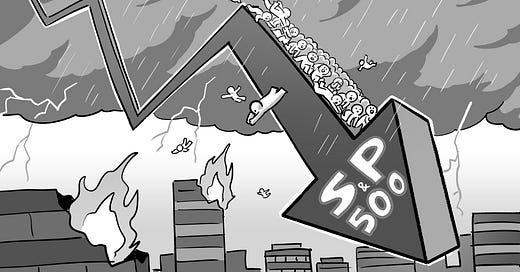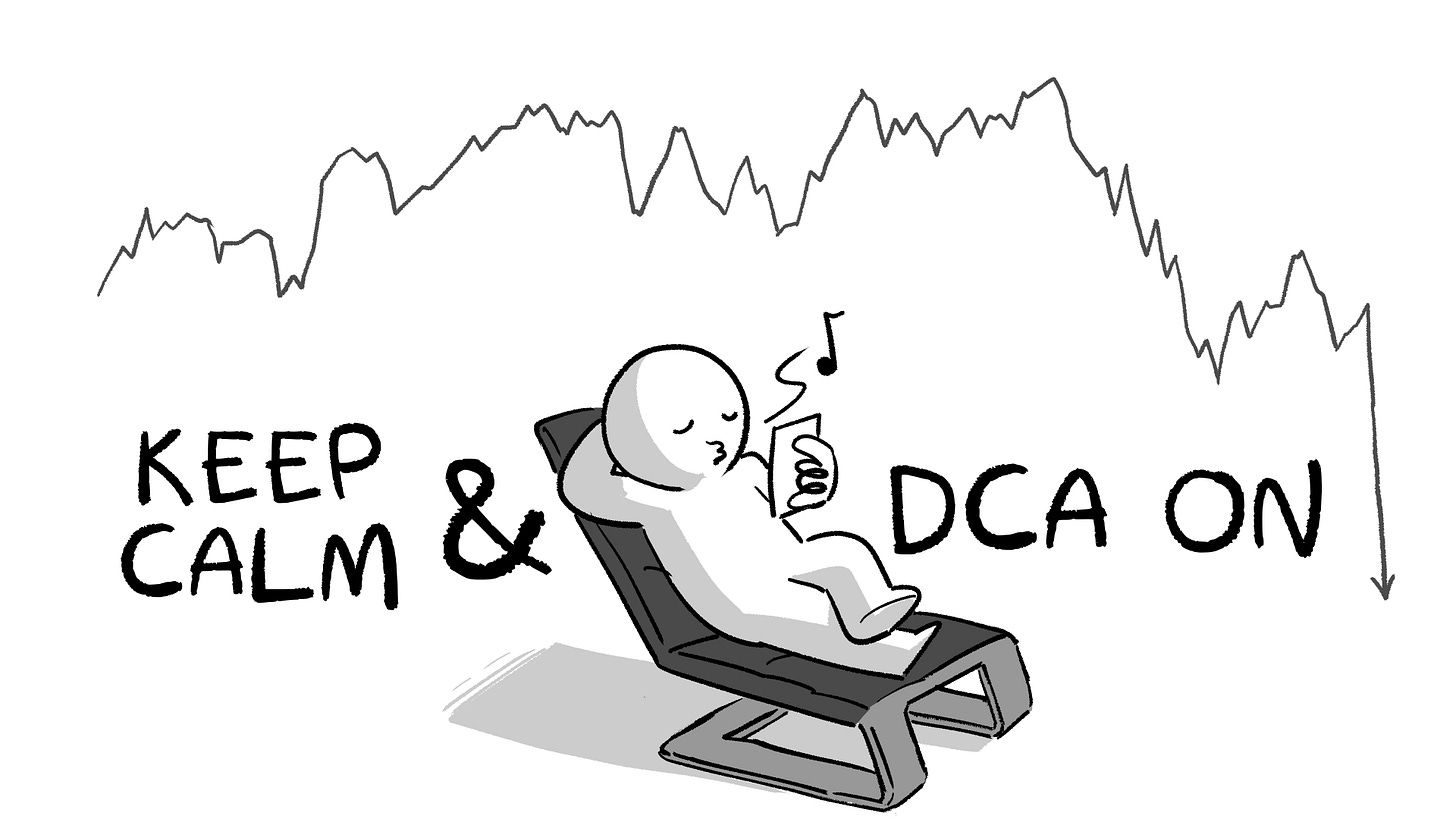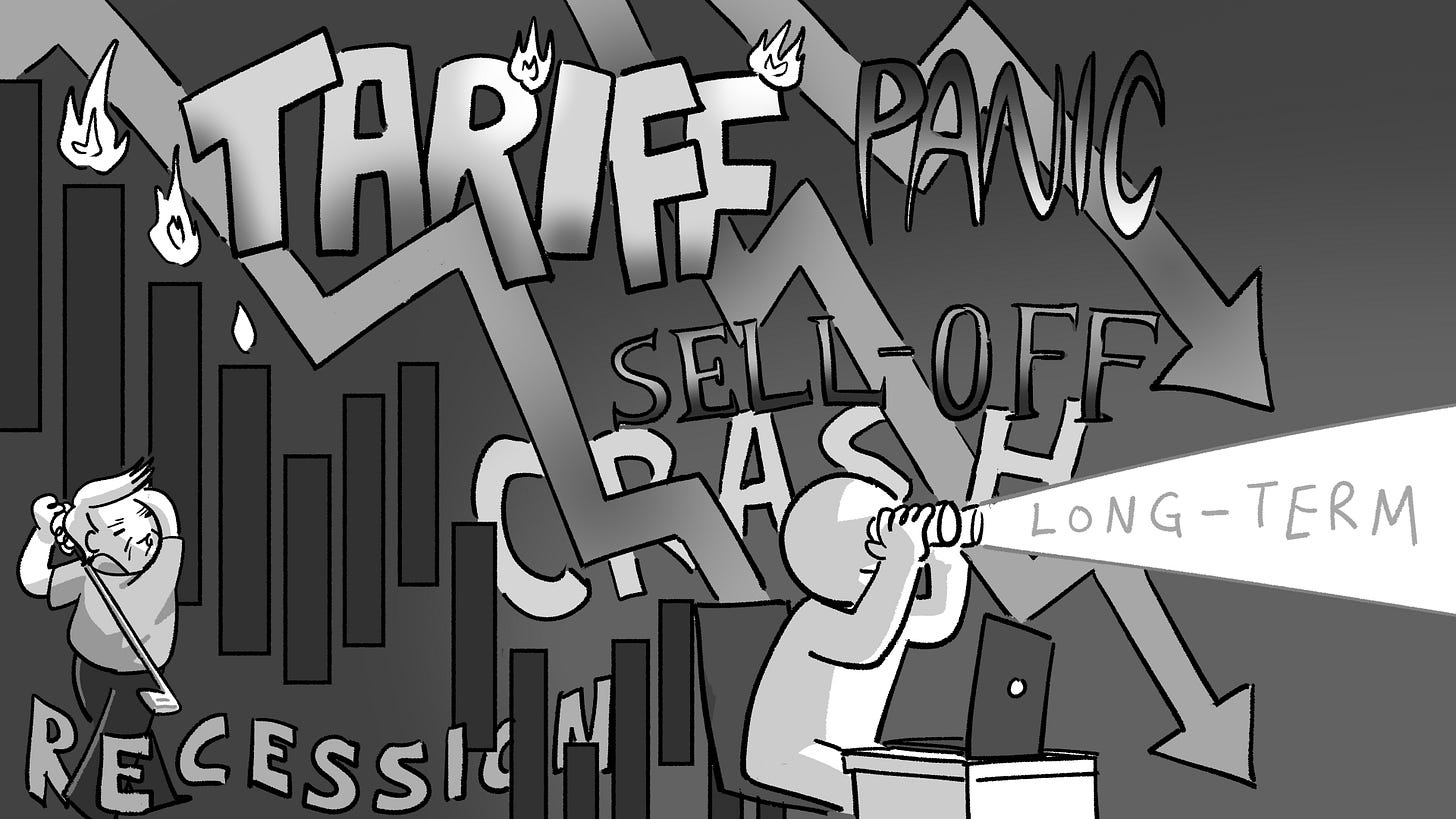With Trump’s trade war, is it still safe to invest in the S&P 500?
Answering the most common questions we got about the S&P 500 after the Liberation Day announcement.
Note: Hi there. We haven’t come up with such content since COVID and the 2022 Market Crash. Why? Because we don’t like to bother people with unnecessary noise. Sometimes the best thing to do is to do nothing. That said, we feel like Trump’s Liberation Day announcement does warrant something. Putting our thoughts here in this article.
Trump’s Liberation Day announcement was so scary that it triggered Singapore’s Prime Minister to make a rare video address to the nation. It also triggered a ~20% drop in the markets. Maybe more by the time you read this.
Because of that, we received some questions about our investing strategy — which includes the S&P 500.
Short answer: YES, we still believe the S&P 500 index funds are a good choice for investors. But there are also risks involved.
Here’s a laundry list of thoughts to address some FAQs or common responses to this.
How are you investing during this period?
I’m staying invested in the S&P 500. Not selling — still buying.
I’m dollar-cost averaging (DCA) via Endowus every month on the 1st and 15th. Every time the market drops 5%, I make a separate manual lump sum investment via Interactive Brokers.
DCA ensures I invest regularly.
Manual lump sum investing is a test of my willpower to stay invested.
(That being said, lump-sum investing on dips works if you’re prepared for more pain after you buy. The market can always go lower.)
“I will wait for it to fall further before I buy it.”
Of course you say that. But we don’t know when that’ll be. The S&P 500 could tank today and hit an all-time high in three months. What you’re doing is investing based on vibes and emotions. Which is bad.
The best way to invest is to come up with a clear, rules-based system so you actually invest.
For example:
I will invest $XXX on the 1st of every month
I will invest when the market falls ~5%
I will invest 20% of my salary every month after hitting my emergency fund
Rules triumph emotions when it comes to investing.
Don’t invest money you will need in the next 15 years.
Looking at 100 years of S&P 500 history, the longest time it stayed ‘flat’ was 15 years — after the Great Depression. The second longest was 10 years — between the Dot-Com Bubble and Great Recession.
If we use these as benchmarks, be prepared for your investments to stay down or flat for up to 15 years.
Another reason not to invest short-term money: there’s a real chance of a recession — and unemployment, depending on your industry.
If there was ever a time to shore up your emergency fund and hold off unnecessary purchases — now would be ideal.
(Btw, if you’re already living off your investments or planning to FIRE soon, it might be time to rebalance and derisk, too. This article was written for an audience of Gen Z and Millennials who are likely still in the wealth-building phase.)
“Why such belief in the stock market recovery?”
First of all — historically, the US stock market has always recovered in the long term (15 years: see above).
And while there are many cases where stock markets never recovered (Russia’s MOEX, Japan’s NIKKEI 225 etc), I think there’s something uniquely different about the companies listed on the S&P 500.
These are large, global businesses that many of us cannot imagine living in a world without. A lot of their earnings don’t come from just the US, but also the world.
Even if some of these companies fail, the S&P 500 has a built-in reset mechanism.
Companies that fall behind get removed. New winners take their place.
So in a way, when you invest in the S&P 500, you're not betting on specific companies — you're betting on capitalism’s ability to adapt, reinvent, and keep pushing forward.
“Why invest in S&P 500, it’s deeply flawed.”
Absolutely, the S&P 500 has a lot of problems with it, including being overly concentrated with seven major tech stocks (Apple, Amazon, Alphabet (Google), Meta Platforms, Microsoft, Nvidia, and Tesla).
However, we believe the alternative for most people is worse. Not a lot of people will admit it, but the chance of you picking the wrong stocks is likely higher. So is the risk of not investing at all.
“Why not bonds?”
Bonds are a safe bet during turbulent times. And yes, you should have some bonds in your portfolio.
However, to grow your money long term, you need some equities (like the S&P 500) too.
All bonds = stable value, but slow death from inflation
All equities = high risk, high volatility
Balance is key.
“What about scary headlines from fund managers?”
They might be right. But we’re playing a different game.
Fund managers and analysts need to deliver results every quarter. Their decisions are short-term by design.
Your job is to invest for the long term. Your bonus doesn’t depend on timing the market.
Use that advantage. Stay invested. Don’t panic sell.
“What if the US stops being the world leader?”
Yes, the US is politically messy, socially divided, and economically unequal. But flawed as it is, it still has major advantages.
If we compare it to China (or even Europe or Japan), it has one clear edge: Demographics.
The US population is still growing — through migration and births. China, on the other hand, has an ageing, shrinking population. That has serious implications for its long-term dominance.
Also — this is likely Trump’s last term as president. We can still hope for some return to normalcy after that.
As Warren Buffett says: Never bet against America.
But — a US decline isn’t 100% off the table. That’s why…
… if you follow The Woke Salaryman way of investing, you’ll know we’ve always advocated diversification across companies, industries, asset classes — and most relevant now — geographies.
For example:
We still invest in things like the much-mocked STI ETF (Singapore), as well as global ETFs like VWRD, IWDA, EIMI.
Yes, for the past 10 years, these underperformed the S&P 500. But diversification exists for exactly these moments.
It’s not impossible that one of these outperforms the S&P 500 in the next five, 10, or even 50 years.
If the S&P 500 somehow still goes to zero…
Then I assure you — we’ll have bigger problems than “losing money in investments”.
We’d likely be in WW3, or worse. The US would’ve decoupled from the global economy, ushering in a new form of feudalism.
Conventional financial planning assumes a relatively peaceful world — one we’ve had for 70 years.
If that changes, then no amount of market-timing or portfolio tweaks will save you.
You’d be better off learning how to grow vegetables, fix leaks, or set up a water filtration system.
Finally – yes – the Trump Tariffs are bad…
There’s nothing worse than a trade war.
… Or is there?
How about a global pandemic that shuts the world down indefinitely? That shutters businesses, kills millions, and halts global trade?
That was pretty bad too, amirite?
When COVID-19 first hit, it felt like the end of the world. But the world didn’t end — we adapted.
At the moment, we don’t know:
How or when the tariffs will be implemented
Whether they’ll stick around
Or if Trump will backtrack on them (he’s known to)
The rest of the world might band together to trade and still make things work.
In the long term, humanity finds a way.
So our task to you? Hang in there for the long term.
Stay woke, salaryman.
TLDR: If you're young, have a long time horizon, and invest consistently (with a plan), S&P 500 index funds remain a solid choice — even if the headlines are scary and the future looks uncertain. Just don't forget to diversify, keep cash for emergencies, and focus on what you can control.
If you’ve read this far, please consider subscribing to our email newsletter (yes, this Substack). We cannot offer you much but we can offer this:
We have newsletter-exclusive articles that won’t be posted anywhere else. We created these articles for people who want to go deeper into complex issues than the shorter-form content we typically have.
If you don’t have social media or don’t follow our Telegram channel, you can still get updates to all our content emailed directly to your inbox to read at your own time.
We promise not to spam your inbox (but Substack might, so update your notification settings).











Hello The Woke,
I hope this communique finds you in a moment of stillness.
Have huge respect for your work and reflective pieces.
We’ve just opened the first door of something we’ve been quietly handcrafting for years—
A work not meant for everyone or mass-markets, but for reflection and memory.
Not designed to perform, but to endure.
It’s called The Silent Treasury.
A place where conciousness and judgment is kept like firewood: dry, sacred, and meant for long winters.
Where trust, vision, patience, resilience and self-stewardship are treated as capital—more rare, perhaps, than liquidity itself.
This first piece speaks to a quiet truth we’ve long sat with:
Why many modern PE, VC, Hedge, Alt funds, SPAC, and rollups fracture before they truly root.
And what it means to build something meant to be left, not merely exited.
It’s not short. Or viral.
But it’s a multi-sensory experience and built to last.
And, if it speaks to something you’ve always known but rarely seen heartily expressed,
then perhaps this work belongs in your world.
The publication link is enclosed, should you wish to experience it.
https://helloin.substack.com/p/built-to-be-left?r=5i8pez
Warmly,
The Silent Treasury
A vault where wisdom echoes in stillness, and eternity breathes.